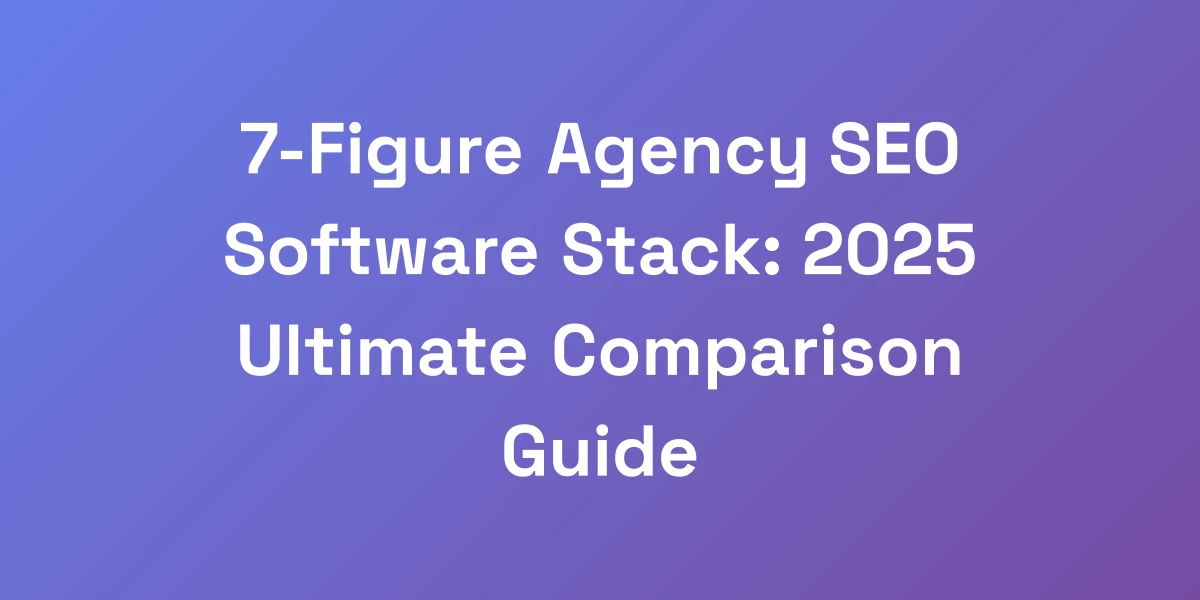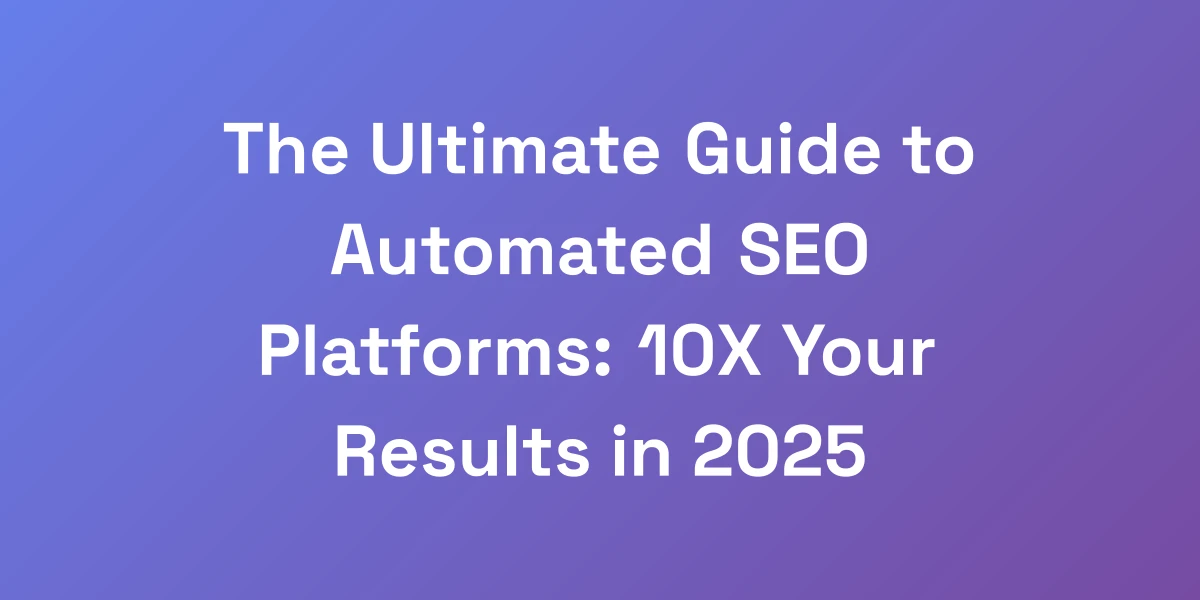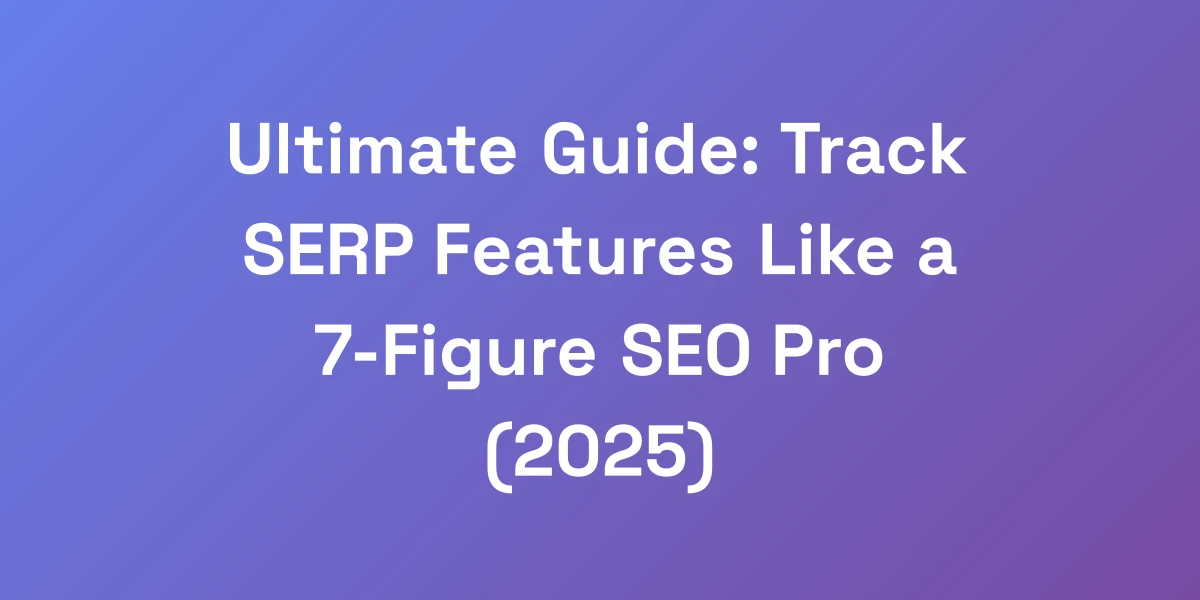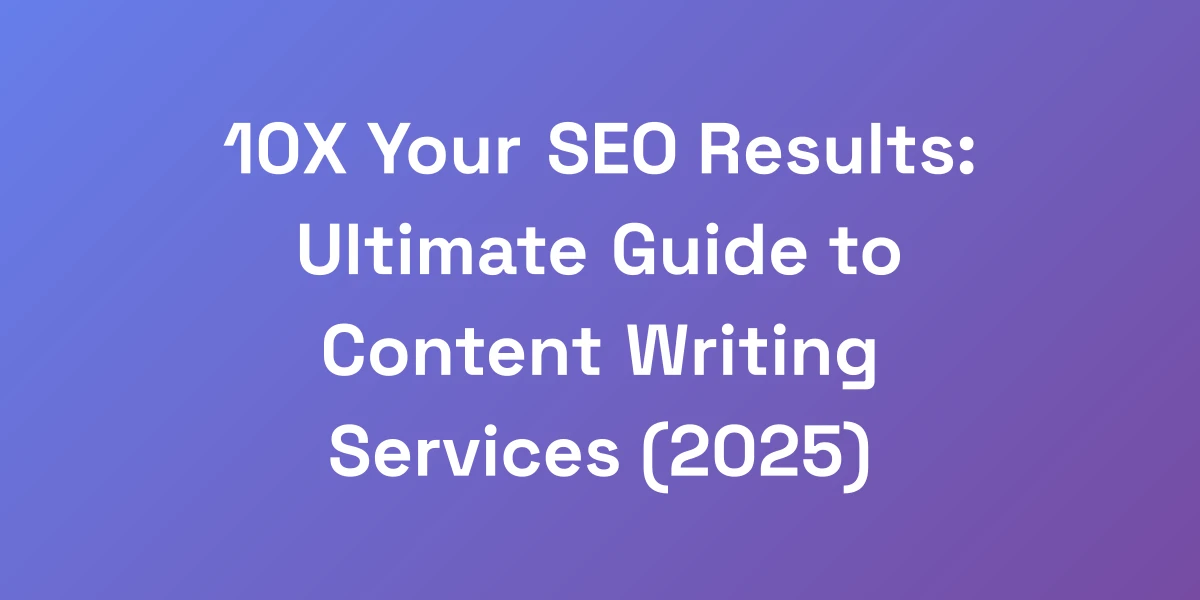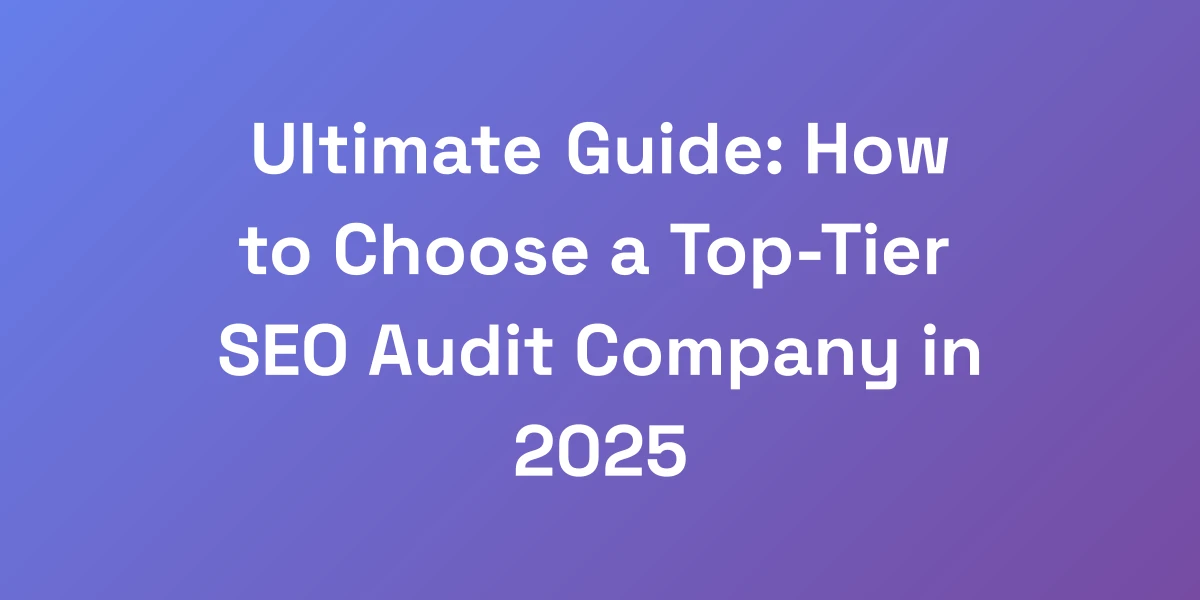
Ultimate Google SEO Audit Guide: 7-Figure Results in 2025
Apr 11, 2025 | By [email protected]
Introduction
We all know the drill: invest countless hours and dollars into an SEO audit, only to watch mediocre results trickle in. It’s frustrating, right?
But here’s the kicker—90% of SEO audits are falling flat because they’re missing the mark.
We’re not here to add you to that statistic. Instead, we’re diving deep into an Ultimate Google SEO Audit Guide designed to propel your business towards 7-figure results by 2025.
Stand by as we unravel the secrets to transforming your SEO strategy from mediocre to unstoppable. Ready to conquer the Google algorithm update 2024 roundup rankings? Let’s go.
Why Most SEO Audits Fail (And How to Win)
Let me be brutally honest—traditional SEO audits are often a complete waste of time.
They bombard you with endless SEO audit checklists and irrelevant metrics that do nothing for your bottom line.
What matters is identifying and fixing the critical issues that are actually holding back your rankings.
In this section, we’ll dissect why most SEO audits flop and how you can flip the script to achieve extraordinary results.
The Fatal Flaws in Traditional SEO Audits
Traditional audits focus on ticking boxes rather than driving results.
They often overlook the most impactful factors and drown you in data that doesn’t translate to growth.
- Overemphasis on Minor Metrics: Spending time on low-impact metrics can divert resources from what truly matters.
- Lack of Strategic Focus: Without a clear strategy, audits become a scattergun approach with little return.
- Ignoring User Intent: Failing to align SEO efforts with what users are actually searching for.
Real-life Scenario: A B2B client invested heavily in backlink quantity over quality, only to see minimal improvement. The missed focus on user intent and content relevance were the real issues.
The 80/20 Principle of SEO Optimization
Not all efforts yield equal results. Applying the 80/20 Principle can dramatically improve your SEO outcomes.
- Focus on High-Impact Areas: Identify the 20% of actions that will drive 80% of your results.
- Streamline Your Efforts: Concentrate resources on strategies that provide the most significant returns.
- Eliminate Waste: Stop wasting time on low-impact tasks that don’t contribute to your goals.
Actionable Tip: Conduct a Pareto Analysis to identify which SEO activities are delivering the most traffic and prioritize accordingly.
Why Google’s Own Tools Are Your Secret Weapon
Forget the expensive third-party tools. Google’s own suite of tools is all you need to perform a comprehensive SEO audit.
- Google Search Console: Unveil critical insights into how Google views your site.
- Google Analytics: Dive deep into your traffic and user behavior data.
- PageSpeed Insights: Optimize your site’s performance to enhance user experience.
Real-Life Example: By leveraging Google Search Console, a client identified and resolved crawl errors that significantly boosted their organic traffic within weeks.
Setting Up Your Audit for Maximum Impact
Setting up your SEO audit correctly is the foundation for success.
- Define Clear Objectives: Know what you want to achieve from the audit.
- Gather Comprehensive Data: Use Google’s tools to collect all relevant data points.
- Create a Structured Plan: Organize your findings and prioritize actions based on impact.
Actionable Tip: Start with a site crawl using Google Search Console to identify immediate technical issues that need fixing.
Essential Google Tools for Professional SEO Audits
Stop throwing money at costly SEO tools. Google provides powerful, free tools that are indispensable for any professional SEO audit.
We’re talking about Search Console, Analytics, and PageSpeed Insights—the holy trinity of SEO auditing.
These tools give you direct access to how Google sees your site. The key is knowing exactly what to look for and how to interpret the data.
We’ll show you how to leverage these tools like a pro, focusing on the metrics that actually move the needle.
Mastering Google Search Console for Deep Insights
Google Search Console is your window into how Google interacts with your website.
- Performance Reports: Analyze clicks, impressions, and average ranking positions for your keywords.
- Coverage Reports: Identify and fix indexing issues that could be preventing your pages from appearing in search results.
- Enhancements: Optimize your site’s mobile usability and Core Web Vitals.
Actionable Tip: Regularly monitor the Coverage Report to catch and fix errors promptly, ensuring your site remains accessible to Google’s crawlers.
Leveraging Google Analytics 4 for SEO Gold
Google Analytics 4 (GA4) offers advanced tracking capabilities that can supercharge your SEO efforts.
- User Behavior Analysis: Understand how visitors interact with your site and identify areas for improvement.
- Conversion Tracking: Measure the effectiveness of your SEO strategies in driving conversions.
- Audience Segmentation: Tailor your SEO strategies to different user segments for maximum impact.
Real-Life Scenario: A client used GA4 to uncover a high drop-off rate on a key landing page, allowing them to optimize the content and layout, resulting in a 25% increase in conversions.
PageSpeed Insights: Beyond the Basic Scores
Page load speed is a critical factor for both user experience and SEO.
- Core Web Vitals: Focus on Largest Contentful Paint (LCP), First Input Delay (FID), and Cumulative Layout Shift (CLS).
- Performance Metrics: Identify and resolve issues slowing down your site.
- Optimization Recommendations: Implement actionable suggestions to enhance your site’s speed.
Actionable Tip: Use PageSpeed Insights to identify and fix high-impact performance issues, such as optimizing images and leveraging browser caching.
Mobile-First Indexing Checks
With Google’s mobile-first indexing, ensuring your site performs flawlessly on mobile is non-negotiable.
- Responsive Design: Ensure your site adapts seamlessly to different screen sizes.
- Mobile Usability: Check for issues like touch elements being too close or text being too small.
- Performance on Mobile: Use tools like Google Search Console to monitor and improve mobile performance metrics.
Real-Life Example: A luxury brand optimized their site for mobile, resulting in a 1100% growth in SEO traffic within 10 months post-redesign.
Core Web Vitals Analysis
Core Web Vitals are essential metrics that reflect your site’s user experience and directly impact SEO rankings.
- Largest Contentful Paint (LCP): Aim for under 2.5 seconds to ensure quick load times.
- First Input Delay (FID): Keep it under 100 milliseconds to maintain responsiveness.
- Cumulative Layout Shift (CLS): Maintain below 0.1 to avoid unexpected layout shifts.
Actionable Tip: Regularly monitor and optimize your Core Web Vitals using Google’s tools to stay ahead of the competition and provide a superior user experience.
The 7-Step Google SEO Audit Framework
We’re talking about a game-changing framework that separates six-figure sites from the rest.
It’s not about checking every possible SEO factor—it’s about focusing on high-impact actions that drive real results.
This system has helped our clients achieve page one rankings for competitive keywords in record time.
The best part? You can complete this audit in under 4 hours, but the impact will last for months.
Technical Foundation Assessment
A solid technical foundation is the bedrock of effective SEO, especially when addressing B2B technical SEO issues.
- Site Architecture: Ensure your site is logically structured and easily navigable.
- URL Structure: Use clean, keyword-rich URLs that make sense to both users and search engines.
- XML Sitemaps: Submit accurate sitemaps to help Google crawl and index your site effectively.
Actionable Tip: Conduct a thorough site crawl using Google Search Console to identify and fix crawl errors that could hinder your site’s performance.
Content Quality and Relevance Analysis
Content is king, but only if it’s high-quality and relevant to your audience.
- Content Audit: Evaluate your existing content for quality, relevance, and performance.
- Keyword Optimization: Ensure your content naturally incorporates target keywords and semantic variations.
- User Intent Alignment: Create content that directly addresses the needs and questions of your audience.
Real-Life Scenario: After optimizing content for user intent and relevance, a business saw a 10x increase in organic traffic by aligning their content with what users were genuinely searching for. Check out our SEO case studies for more insights.
For businesses looking to enhance their content strategy, blogging for business can be your secret weapon to drive engagement and growth.
User Experience and Core Web Vitals
User experience isn’t just a nice-to-have—it’s a critical SEO factor.
- Navigation: Ensure users can easily find what they’re looking for.
- Visual Design: Create an engaging, aesthetically pleasing interface.
- Core Web Vitals: Optimize for speed, interactivity, and visual stability.
Actionable Tip: Use heatmaps and user session recordings to understand how users interact with your site and identify areas for improvement.
Backlink Profile Evaluation
Backlinks remain a powerful ranking factor, but quality trumps quantity.
- Link Quality: Focus on acquiring links from high-authority, relevant sites.
- Anchor Text Diversity: Use a natural mix of anchor texts to avoid penalties.
- Disavow Toxic Links: Regularly clean your backlink profile by disavowing harmful links.
Real-Life Example: By enhancing their backlink profile with high-quality links, a client doubled their organic traffic and improved their rankings for several competitive keywords.
Competitive Gap Analysis
Understanding your competition is crucial for identifying opportunities and threats.
- Identify Competitors: Determine who your main SEO competitors are.
- Analyze Competitor Strategies: Examine their content, backlink profiles, and on-page optimizations.
- Find Your Edge: Identify gaps in their strategies that you can exploit to gain a competitive advantage.
Actionable Tip: Use tools like SEMrush or Ahrefs to conduct a comprehensive competitor analysis and uncover actionable insights to enhance your own SEO strategy.
Mobile Optimization Check
With the rise of mobile usage, ensuring your site is mobile-optimized is non-negotiable.
- Responsive Design: Ensure your site looks and functions well on all devices.
- Page Load Speed: Optimize your mobile site for fast loading times.
- Mobile Usability: Ensure touch elements are appropriately sized and spaced.
Real-Life Scenario: By optimizing their site for mobile, a client saw a significant increase in mobile traffic and improved their overall search rankings.
Schema Markup Implementation
Schema markup helps search engines understand your content better and enhances your search visibility.
- Structured Data: Implement schema to provide additional context to your content.
- Rich Snippets: Enable rich snippets to make your listings more attractive in search results.
- Entity Optimization: Use schema to highlight key entities on your site, improving their prominence in search results.
Actionable Tip: Use Google’s Structured Data Markup Helper to add schema to your site and validate it with the Structured Data Testing Tool.
Advanced SEO Audit Techniques for 2025
The SEO game is evolving, and your audit needs to keep pace.
Forget outdated metrics like keyword density. In 2025, it’s all about entity optimization, user intent matching, and AI content evaluation.
We’ll reveal the cutting-edge techniques that are working right now, including how to optimize for Google’s increasingly sophisticated algorithm updates and leverage AI tools without getting penalized.
Entity-Based SEO Analysis
Entities are the building blocks of today’s SEO landscape. It’s not just about keywords anymore.
- Entity Identification: Recognize key entities relevant to your niche.
- Entity Relationships: Understand how entities are connected within your content.
- Schema Integration: Use schema markup to highlight these entities effectively.
Real-Life Example: A client focused on entity optimization by structuring their content around key industry terms, resulting in improved search visibility and higher rankings for related queries.
AI Content Quality Assessment
AI is transforming content creation, but quality remains paramount. Discover how autoblogging can be leveraged to maintain high content standards while maximizing efficiency.
- Content Authenticity: Ensure your content is original and provides real value.
- AI Tools: Utilize AI-driven tools to enhance content quality without sacrificing authenticity.
- Human Oversight: Maintain a human touch in your content to keep it engaging and relevant.
Actionable Tip: Use tools like Grammarly and Hemingway to refine AI-generated content, ensuring it meets your quality standards.
Voice Search Optimization
Voice search is on the rise, and optimizing for it is crucial.
- Conversational Keywords: Incorporate natural language and long-tail keywords that reflect how people speak.
- Featured Snippets: Aim for position zero by optimizing content to answer specific questions directly.
- Local SEO: Ensure your business is optimized for local voice searches with accurate Google Business Profiles.
Real-Life Scenario: By optimizing for voice search, a local business saw a significant uptick in mobile traffic and local search visibility.
E-E-A-T Signal Analysis
Experience, Expertise, Authoritativeness, and Trustworthiness (E-E-A-T) are critical for Google’s evaluation of your site.
- Content Quality: Ensure your content demonstrates deep knowledge and provides valuable insights.
- Author Credentials: Showcase the expertise and credentials of your content creators.
- Trust Signals: Incorporate elements like secure HTTPS, clear contact information, and transparent policies.
Actionable Tip: Regularly update your content to reflect the latest information and demonstrate ongoing expertise in your field.
Featured Snippet Optimization
Featured snippets can skyrocket your visibility and click-through rates.
- Answer Questions Directly: Format your content to provide clear, concise answers to common questions.
- Use Structured Formats: Utilize lists, tables, and bullet points to make your content snippet-friendly.
- Target Long-Tail Keywords: Focus on specific queries that are more likely to trigger featured snippets.
Real-Life Example: A healthcare provider optimized their blog posts for featured snippets, resulting in a 25.9% increase in CTR for their target keywords.
Local SEO Audit Elements
Local SEO is essential for businesses targeting specific geographic areas.
- Google Business Profile: Ensure your profile is complete, accurate, and optimized with relevant keywords based on the latest local search ranking factors.
- Local Citations: Maintain consistent NAP (Name, Address, Phone number) information across all platforms.
- Customer Reviews: Encourage and manage customer reviews to enhance your site’s reputation and trustworthiness.
Actionable Tip: Regularly update your Google Business Profile with new photos, posts, and responding promptly to customer reviews to boost local SEO performance.
Implementing Your Audit Findings for Maximum ROI
An audit is worthless without proper implementation. We’ve seen companies sit on golden insights because they didn’t know how to execute effectively.
Here’s our proven system for turning audit findings into actionable improvements that drive real revenue. For those managing their projects independently or as SEO freelancers, these strategies are crucial.
We’ll focus on prioritizing changes that give you the biggest bang for your buck, and show you how to measure the impact of every optimization.
Priority Matrix for SEO Fixes
Not all fixes are created equal. Use a priority matrix to determine which issues to tackle first.
- High Impact, Low Effort: Quick wins that provide significant results with minimal effort.
- High Impact, High Effort: Strategic projects that require more resources but deliver substantial ROI.
- Low Impact, Low Effort: Minor tweaks that can be done alongside other tasks.
- Low Impact, High Effort: Avoid or deprioritize these tasks to focus on what matters most.
Actionable Tip: Create a spreadsheet to categorize and track each identified issue within your priority matrix, ensuring you address the most critical areas first.
Implementation Timeline Creation
Without a clear timeline, implementing your audit findings can become chaotic.
- Set Deadlines: Assign realistic deadlines to each task based on priority and resources.
- Assign Responsibilities: Delegate tasks to team members with the appropriate skills and expertise.
- Monitor Progress: Regularly review the timeline to ensure milestones are being met.
Real-Life Scenario: A business created a detailed implementation timeline, facilitating the organized rollout of SEO changes and leading to a 50% increase in organic traffic within six months.
Resource Allocation Strategy
Effective resource allocation ensures you maximize your SEO efforts without overextending your team.
- Identify Key Resources: Determine the tools, budget, and personnel needed for each task.
- Optimize Workflow: Streamline processes to maximize efficiency and reduce bottlenecks.
- Monitor Resource Utilization: Keep track of resource usage to prevent overallocation or underutilization.
Actionable Tip: Use project management tools like Trello or Asana to allocate resources effectively and keep your team on track.
Progress Tracking Methods
Monitoring your progress is essential to ensure your SEO strategies are delivering the desired results.
- Set KPIs: Define key performance indicators to measure the success of your SEO efforts.
- Regular Reporting: Generate regular reports to track progress and identify areas for improvement.
- Adjust Strategies: Be prepared to tweak your strategies based on performance data.
Actionable Tip: Schedule monthly check-ins to review your SEO performance against your KPIs and make necessary adjustments.
ROI Measurement Framework
Measuring the ROI of your SEO audit ensures you understand the value of your efforts and where to invest next.
- Track Conversion Rates: Measure how SEO improvements are translating into conversions and sales.
- Calculate Cost Savings: Identify areas where SEO has reduced costs, such as lower paid advertising spend.
- Analyze Revenue Growth: Directly link SEO efforts to revenue increases to quantify their impact.
Real-Life Example: After implementing their SEO audit, a company tracked a 200% increase in organic sales, directly attributing the growth to their optimized SEO strategies.
Conclusion
We’ve walked you through the ultimate approach to conducting a Google SEO audit that delivers seven-figure results by 2025.
From identifying why most audits fail to leveraging Google’s powerful tools and implementing advanced techniques, you now have the blueprint for SEO success.
Remember, the key isn’t just in performing an audit but in executing the findings effectively to drive real, measurable results.
Ready to transform your SEO strategy and achieve unparalleled growth? Start implementing these strategies today and watch your organic traffic—and revenue—soar.
What’s your biggest SEO challenge right now? Let’s discuss in the comments below and conquer it together.



